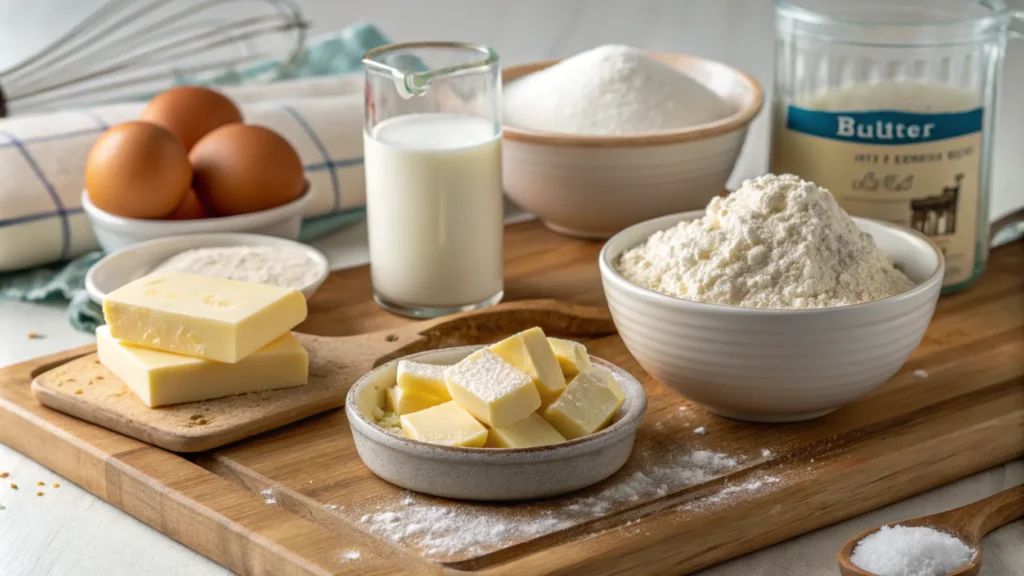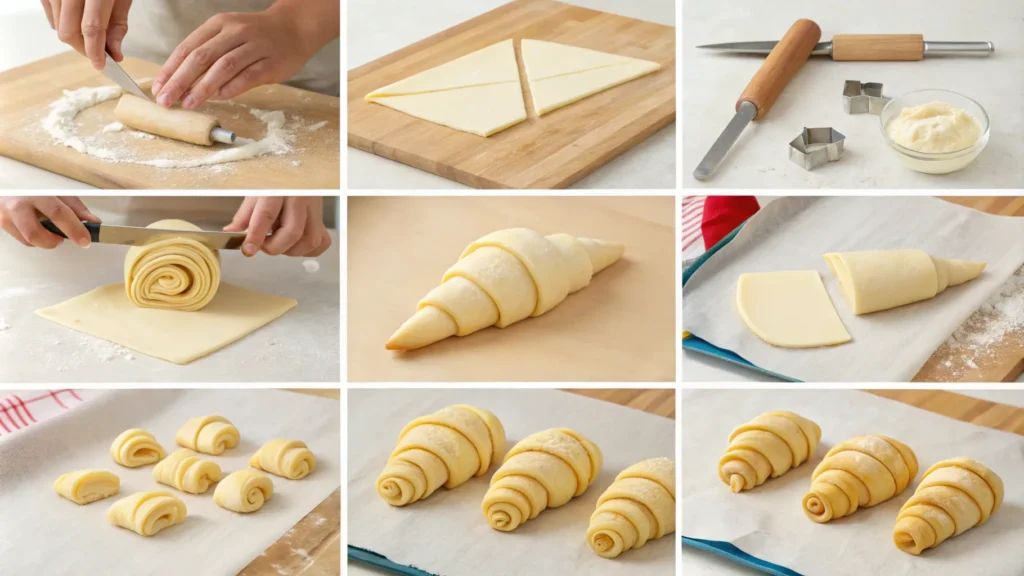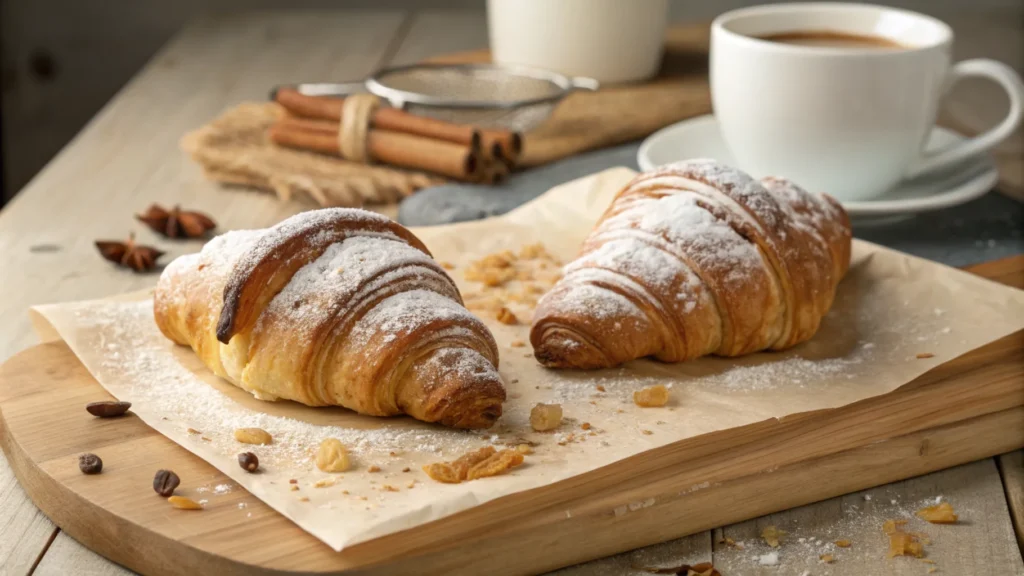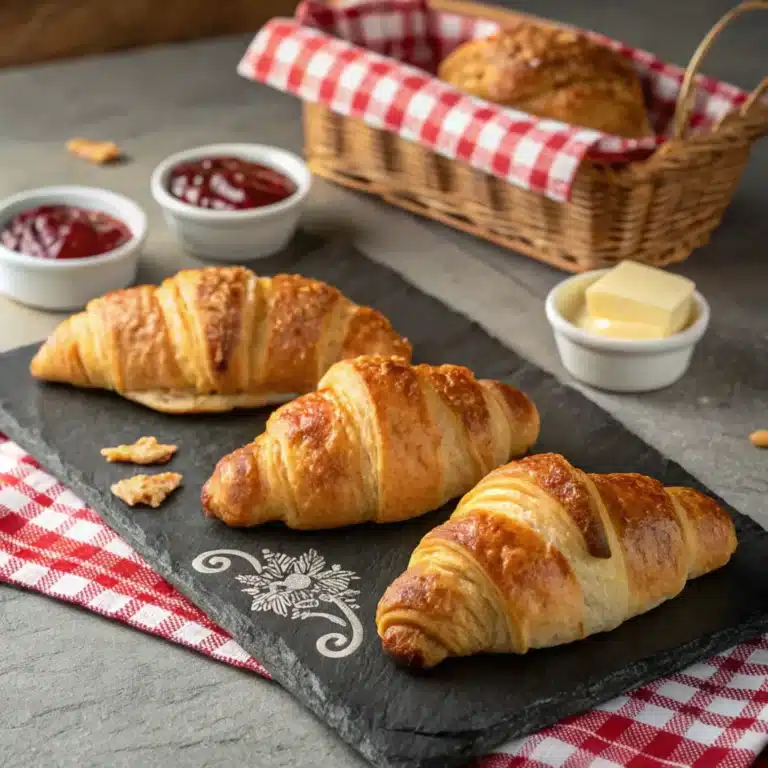The Ultimate Guide to Making Gipfeli at Home
Whether you’re an experienced baker or someone venturing into the world of pastries for the first time, making gipfeli recipe at home is a rewarding culinary adventure. In this guide, we’ll walk you through everything you need to know—from its fascinating origins to crafting the perfect dough, filling options, and pairing suggestions. By the time you’re done reading, you’ll not only know how to bake these Swiss delights but also understand why they hold a special place in European breakfast culture. Let’s dive in!
Table of Contents
Introduction to Gipfeli RECIPE
What is Gipfeli Recipe ?
Gipfeli is a beloved Swiss pastry often mistaken for its French cousin, the croissant. Shaped like a crescent, it boasts a soft, buttery interior encased in a slightly crisp, golden exterior. While similar in appearance, gipfeli has a denser, less flaky texture, making it a hearty addition to any breakfast table. This versatile pastry is cherished not only in Switzerland but across Europe for its simple yet satisfying taste.
Origins and History of Gipfeli Recipe
The story of gipfeli begins in Central Europe, where crescent-shaped breads first emerged in the 17th century. Some accounts trace its origins to Vienna, but the Swiss made this pastry their own by tweaking its texture and flavor. Unlike croissants, which rely heavily on layered butter laminations, gipfeli emphasizes a more bread-like consistency while retaining a buttery richness.
Why Gipfeli Recipe is a Breakfast Staple in Switzerland
In Switzerland, gipfeli isn’t just food—it’s a cultural icon. Served warm with coffee or tea, it’s a morning ritual for many. Its subtle sweetness pairs beautifully with butter, jams, or savory spreads, making it a flexible choice for various tastes. Whether enjoyed plain or filled with chocolate, gipfeli captures the heart of Swiss simplicity and elegance.
Key Ingredients and Equipment for Gipfeli Recipe
Essential Ingredients for Traditional Gipfeli Recipe
Creating a perfect gipfeli recipe starts with the right ingredients. The basics are simple: all-purpose flour, unsalted butter, milk, sugar, yeast, and a pinch of salt. The butter is crucial—it must be high-quality to achieve that signature rich flavor. Some traditional recipes also use an egg to give the dough a tender texture.

For those wanting a slightly sweeter taste, a small amount of vanilla extract can be added, though it’s not essential. To achieve a light, golden crust, don’t forget an egg wash made by whisking an egg with a splash of milk.
Optional Ingredients to Add a Twist
Want to spice things up? Try incorporating fillings like dark chocolate, almond paste, or even ham and cheese for a savory twist. For a festive variation, you can sprinkle powdered sugar or slivered almonds on top after baking.
Tools You Need to Prepare Perfect Gipfeli Recipe
While the ingredients are straightforward, having the right tools can make or break your gipfeli recipe. You’ll need a rolling pin to shape the dough evenly, a sharp knife or pizza cutter to create clean triangles, and a baking tray lined with parchment paper. For best results, a kitchen thermometer Secures your dough rises at the ideal temperature, while a pastry brush helps with that beautiful egg wash glaze.
Part 3: Step-by-Step Gipfeli Recipe
Preparing the Dough: Techniques for Flakiness
Begin by activating your yeast. Mix warm milk, sugar, and yeast in a bowl, letting it sit until frothy. In a large bowl, combine flour and salt, then cut in cold butter until the mixture resembles breadcrumbs. Gradually add the yeast mixture, kneading gently until the dough forms. Cover the dough with a damp cloth and allow it to rise in a warm spot for approximately an hour, or until it has doubled in size
Filling Options: Sweet and Savory Variations
After the dough has risen, roll it out on a lightly floured surface into a large rectangle. If you’re aiming for a classic gipfeli, skip the filling. For sweet variations, place a small square of dark chocolate or a dollop of fruit jam on the widest part of each triangle. Savory fans can use ham, cheese, or spinach for an exciting twist.

Shaping Gipfeli Recipe: Tips for Achieving the Perfect Crescent
Cut the rolled-out dough into long triangles. Starting from the widest edge, roll each triangle tightly toward the tip to create the crescent shape. Make sure the tip is tucked underneath to prevent it from unrolling while baking. For a polished look, gently curve the ends to mimic a crescent moon.
Baking Gipfeli Recipe: Time, Temperature, and Tricks
Preheat your oven to 375°F (190°C). Arrange the rolled gipfeli on a baking tray lined with parchment paper, ensuring they have enough space to expand. Brush each piece with egg wash for that golden, glossy finish. Bake for 15–20 minutes or until they turn a rich, golden brown. Once done, let them cool slightly before serving.
Common Mistakes and How to Avoid Them
Overworking the Dough
One of the most common errors when following a gipfeli recipe is overworking the dough. Kneading too much can make the pastry dense and tough, rather than soft and light. Always handle the dough gently, especially when incorporating butter, to maintain its delicate texture.
Choosing the Wrong Butter
Butter is the star of the show in any gipfeli recipe. Using margarine or low-quality butter can result in a lackluster flavor. Opt for unsalted, high-fat butter for the richest taste and flakiest layers. If possible, keep your butter cold until you’re ready to use it.
Mistakes in Shaping and Baking
Improper shaping can lead to uneven baking. Secure that your gipfeli are rolled tightly and evenly for the best results. Additionally, baking at the wrong temperature can ruin the pastry. Too low, and it becomes pale; too high, and it burns before the inside cooks. Always preheat your oven and monitor your pastries closely.
Pairing and Serving Suggestions
What to Serve with Gipfeli for Breakfast or Brunch
A warm gipfeli pairs beautifully with a variety of accompaniments. For a classic Swiss breakfast, serve it with butter and a selection of fruit jams. If you’re hosting brunch, consider adding fresh berries, creamy yogurt, or a platter of cold cuts and cheeses. A steaming cup of coffee or a frothy cappuccino Improves the experience perfectly.
Gipfeli as a Snack: Perfect Drinks to Complement
Gipfeli isn’t just for breakfast—it’s a versatile snack, too! Pair sweet-filled gipfeli with hot chocolate or herbal tea for an indulgent treat. If you’ve gone the savory route, serve your gipfeli with a crisp white wine or sparkling water to balance the richness.
Suggested Recipe
For more delicious pastries and snack ideas, check out our other recipe articles to inspire your baking journey
Ultimate Guide to Mini Pancakes.
Tips for Perfecting Your Gipfeli Recipe
Practice Patience
Patience is the secret ingredient in any great gipfeli recipe. Allowing the dough to rest properly Secures that the yeast has time to work its magic, creating a light and airy texture. Rushing the rising process can result in dense, underwhelming pastries. If you’re in a hurry, consider prepping the dough a day in advance and letting it rest overnight in the fridge.
Mastering the Butter-to-Dough Ratio
Getting the butter-to-dough ratio just right is essential for achieving that perfect balance of richness without it feeling greasy. Too little butter can leave your gipfeli dry, while too much may cause it to collapse during baking. Measure your ingredients carefully and always use cold butter to Secure it blends Smoothly into the dough.
Testing for Doneness
An underbaked gipfeli won’t have the same delightful texture or flavor. To check for doneness, look for a deep golden-brown crust and lightly tap the bottom of the pastry—it should sound hollow. If in doubt, give them another minute or two in the oven, but keep a close eye to avoid overbaking.
Creative Variations for Gipfeli Recipe
Sweet Variations
When it comes to sweet delights, gipfeli can easily rival the most decadent pastries with a few creative touches. Filling your gipfeli recipe with Nutella or chocolate chips is always a crowd-pleaser. For a fruity alternative, try apricot jam, raspberry preserves, or even a dollop of lemon curd for a zesty kick. To Promote the sweetness, sprinkle a bit of cinnamon sugar inside the dough before rolling.
For an extra-special treat, consider layering marzipan or almond paste into the dough. Not only does it add a luxurious texture, but the subtle almond flavor pairs beautifully with the buttery base. After baking, you can glaze the pastries with a light sugar syrup to give them a bakery-style shine, or drizzle with a mixture of powdered sugar and milk for a quick icing. During the holiday season, infuse the dough with spices like nutmeg, cardamom, or pumpkin spice to bring festive flavors to your table.
For a touch of elegance, sprinkle the tops of your freshly baked gipfeli with slivered almonds or crushed pistachios to Improve both texture and flavor. Complete the look with a light dusting of powdered sugar, creating a classic and refined finish that’s guaranteed to impress.
Savory Twists
If savory flavors are more your style, gipfeli can easily transform into a delicious snack or meal. Classic ham and cheese is a go-to filling that’s rich and satisfying. For an Italian-inspired twist, try prosciutto, mozzarella, and a touch of pesto. Spinach and feta is another excellent choice, offering a Mediterranean vibe with its tangy, creamy center.
For a modern take, experiment with plant-based fillings like roasted vegetables or vegan cheese. These adaptations not only accommodate various dietary preferences but also offer a healthier option that still delivers on taste
Before baking, Improve your savory gipfeli by brushing them with an egg wash and sprinkling the tops with sesame seeds, poppy seeds, or grated Parmesan. These finishing touches add texture and flavor, making each bite irresistible.
Special Dietary Modifications
Dietary restrictions shouldn’t mean missing out on the joys of a perfect gipfeli recipe. For gluten-free versions, substitute a high-quality gluten-free flour blend. While the dough may be slightly more challenging to work with, the end result can be just as delightful. Adding a small amount of xanthan gum can improve the elasticity of the dough and make shaping easier.
For vegan-friendly options, adapting your gipfeli recipe is straightforward and rewarding. Use high-fat plant-based alternatives such as coconut oil or vegan margarine in place of butter. Substitute traditional milk with almond, oat, or soy milk, which integrate smoothly into the dough. To create the iconic golden crust, simply brush the gipfeli with soy milk or a mixture of maple syrup and water. These adjustments Secure your vegan pastries remain rich, flaky, and irresistibly golden. These easy substitutions guarantee your pastries stay rich, flaky, and deliciously golden while catering to plant-based diets.
These small changes preserve the pastry’s rich texture and flavor while catering to plant-based diets. Moreover, non-dairy alternatives allow for endless customization, whether adding spices or drizzling vegan chocolate. With these adjustments, gipfeli remains a versatile and delicious treat for everyone to enjoy!
FAQs
What is the Difference Between Gipfeli and Croissant?
While gipfeli and croissants may look alike, there are some key differences. Croissants are known for their flaky, layered texture created by laminating butter into the dough. In contrast, a gipfeli recipe focuses on a simpler dough with a denser, bread-like consistency. The Swiss version is often slightly sweeter and less buttery than its French cousin, making it a distinct pastry in its own right.
Can I Freeze Gipfeli Dough?
Absolutely, gipfeli dough can be frozen for future use. Shape the dough into crescents, place them on a baking tray, and freeze until firm. Once frozen, move them to an airtight container or freezer bag. When you’re ready to bake, thaw the dough in the refrigerator overnight and continue with the regular baking process
How Long Can Gipfeli Stay Fresh After Baking?
Freshly baked gipfeli are at their best when eaten within a day or two. If needed, you can keep them in an airtight container at room temperature for up to three days. To bring back their crispiness, warm them in a preheated oven for a few minutes before serving.

Conclusion: Mastering the Art of Gipfeli
Recap of Key Techniques
Mastering the perfect gipfeli recipe takes patience, quality ingredients, and a touch of practice. From gently preparing the dough to shaping the crescents with care, each step contributes to a delicious result. Remember to use high-quality butter and follow the proper baking temperatures for that signature golden finish.
Encouragement to Experiment with Flavors
Once you’ve mastered the basics, let your creativity shine! Experiment with sweet or savory fillings to personalize your gipfeli. Whether it’s a classic chocolate-filled pastry or a ham-and-cheese variation, the possibilities are endless.
With this guide, you’re ready to bring the delightful taste of Swiss baking into your home. Happy baking!

